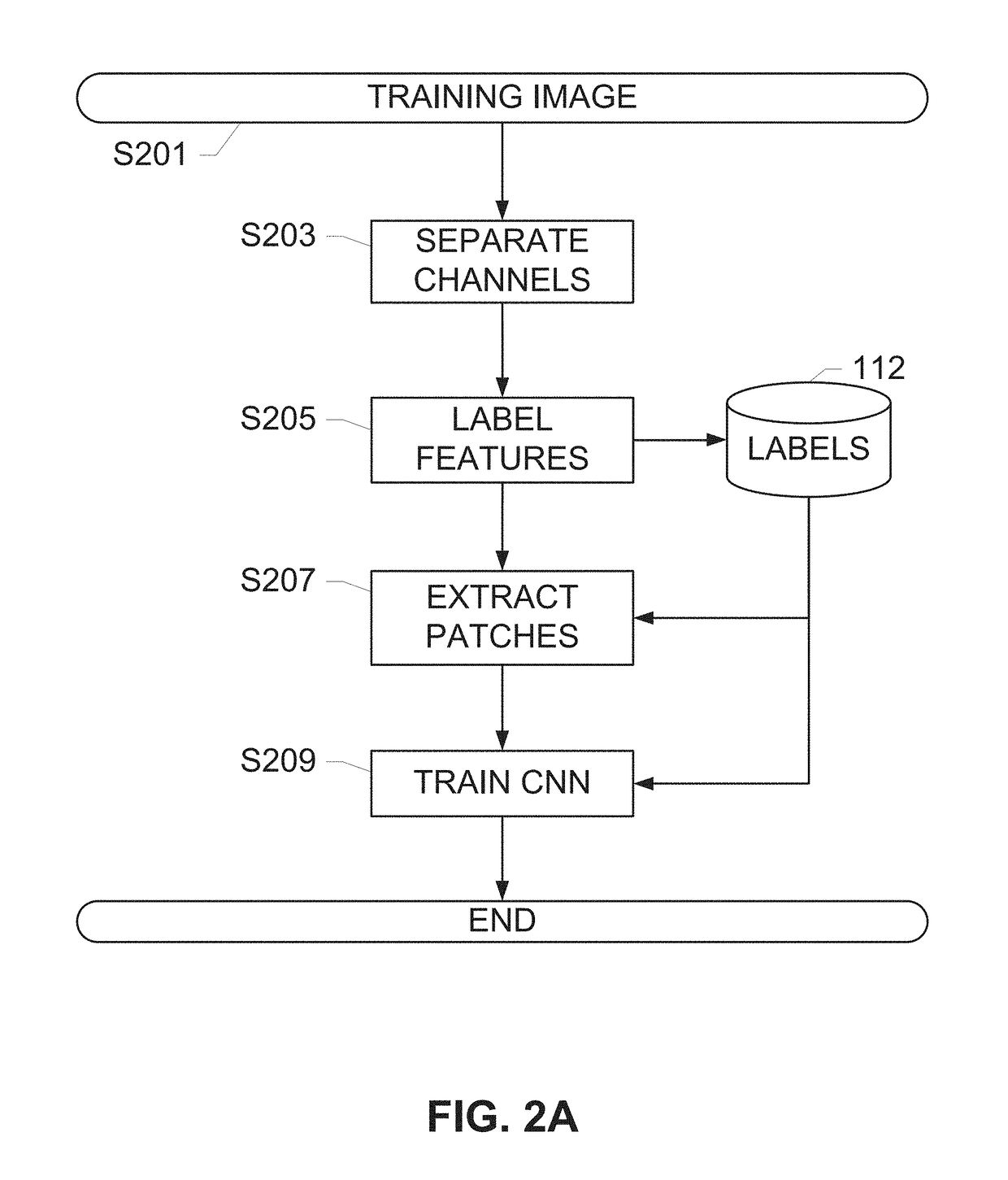[0018]Embodiments of the invention are particularly advantageous as a convolutional neural network is employed for generating a probability map representing a probability for the presence of the biological features that has a structure which facilitates the training of the convolutional neural network (CNN), provides enhanced stability and reduces the computational burden and latency times experienced by the user. This is accomplished by connection mapping of the inputs of the CNN to feature maps of its first convolutional layer such that subsets of the channels that are representative of co-located biological features are mapped to a common feature map. By using the a priori biological knowledge as regards the co-location of stains a structure is thus enforced onto the CNN that has these advantageous effects. This is done by a step of configuring the CNN correspondingly.
[0019]In accordance with an embodiment of the invention the number of feature maps is below the number of channels of the multi-channel image. This is particularly advantageous for reducing the computational burden and increased stability of the CNN as well as to reduce the number of training images that are required for training the CNN.
[0020]In accordance with a further embodiment of the invention the image sensor that is used to acquire the multi-channel image has a number of color channels that is below the number of channels of the multi-channel image. The co-location data that describes the co-location data that describes the co-location of stains may be utilized for performing the unmixing, such as by using a group sparsity model as it is as such known from the prior art. This way the co-location data can be used both for performing the unmixing and for configuring the CNN.
[0021]The subject disclosure solves the above-identified problems by presenting systems and computer-implemented methods for automatic or semi-automatic detection of structures of interest within images, for example, cellular structures (e.g., cells. nuclei, cell edges, cell membrane), background (e.g., background patterns such as white or white-like space), background image components, and / or artifacts. In exemplary embodiments of the present invention, the present invention distinguishes cellular structures in an image from non-cellular structures or image components. The structures or components may be identified using a convolutional neural network that has been trained for this task. More particularly, the convolutional neural network may be trained to recognize specific cellular structures and features using training images and labels. The neural network outputs a probability that the detected structure does in fact represent a cell, membrane, background, etc. These probabilities may undergo a local maxima finding method such as non-maximum suppression in order to identify a particular pixel that will be used as the “location” of the object. A particular part of the cell, e.g., the approximate center of a nucleus, is illustratively used as the “location” of the object within the area under observation, i.e. an image patch.
[0022]Operations described herein include retrieving individual color channels from a multi-channel image and providing said multiple individual channels as input for a detector, for example, a cell detector. The cell detector may comprise a learning means that is trained using ground truths for cellular structures, such as cells, portions of cells, or other cell or image features identified by a trained operator, such as a pathologist. The trained cell detector may be used to identify cellular structures, such as immune cells, in the channels of the image that correspond to multiple types of cell markers or other target structures such as a nucleus. The learning means may include generating a convolutional neural network (CNN) by analyzing a plurality of training images with ground truths labeled thereon. Subsequent to the training, a test image or image under analysis may be divided into a plurality of patches, each patch containing one or multiple channels that are classified according to a CNN, and a probability map may be generated representing a presence of the immune cell or other target structure within the image. Further, a non-maximum suppression operation may be performed to obtain the coordinates of the target structure from the probability map.
[0023]In exemplary embodiments described herein, multiple types of cells, for example, immune cells may be detected from a multi-channel image, such as an original RGB image acquired from a brightfield imaging system, an unmixed fluorescent image, or an image in any other color space such as LAB. In alternate exemplary embodiments described herein, the detection can be applied to selected regions of the image instead of the whole image, and for example, enabled by detecting the foreground of the image, and only apply detection within the foreground region. To accelerate this cell detection process, a precomputed foreground mask can be used to enable processing of only regions of the image that are likely to contain immune cells in their foreground.
 Login to View More
Login to View More  Login to View More
Login to View More 


